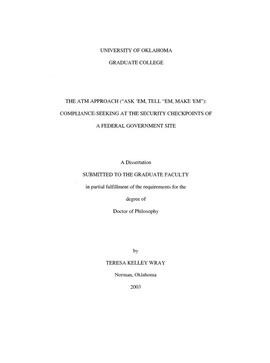| dc.contributor.advisor | Wieder, D. Lawrence, | en_US |
| dc.contributor.author | Wray, Teresa Kelley. | en_US |
| dc.date.accessioned | 2013-08-16T12:19:04Z | |
| dc.date.available | 2013-08-16T12:19:04Z | |
| dc.date.issued | 2003 | en_US |
| dc.identifier.uri | https://hdl.handle.net/11244/643 | |
| dc.description.abstract | Recent terrorist attacks in the United States have increased public concern with security screeners, yet research does not exist of communication at security checkpoints. The goals of this study are: (1) to initiate social science study of private police communication; (2) to add to the sparse naturalistic studies of policing from the communication perspective; (3) to examine compliance-seeking at the security check; and (4) conduct a discursive analysis of the everyday activities of officers during the security check at a federal government multi-building site in the Northeast U.S. The first four chapters are: (1) a short history of public and private policing; (2) instances of compliance-like exchanges extracted from 1960s/1970s policing ethnographies, one private police account, and news stories of security and SAS encounters at airports; (3) method of several months' observation, audio-taping, recording detailed field notes, and interviews of officers; (4) narrative account of typical work days at Government Buildings for both a public and private police officer. I follow Goffman's (1961) conceptualization of encounters; Hymes' (1974) ethnography of communication; Searle's (1969) speech act theory; Etizioni's (1961) concepts of normative, and social power; and Philipsen's (1975) concept of counter incidents all inform my analysis of preferred communication modes: politeness and acknowledgement, face needs and verbal immediacy after directives and reproaches; politeness as the normative power use through respectful address; speech acts and repetition; officer local knowledge and tacit knowledge. In sum the officer who subscribes to "being the bigger person" at Government Buildings employs, language that is generally polite (acknowledgements), treats others with respect (politeness) when possible and teaches (reproaches) when necessary, is warm but professionally distant (immediacy), and completes the job with efficiency (directives). I found a range of compliance (derived from on-site interactions or as-told-to examples): compliance that is complete, limited, limited with objection, passive-resistant, eventual with protest, non-compliance or avoidance, over- or distracted. Future research should be based in actual interaction, consider specific relationships within the larger organizational and cultural contexts, examine emotion management of self and others, look at the whole picture of nonverbal/verbal social influence, and study humor in compliance-seeking. | en_US |
| dc.format.extent | viii, 203 leaves : | en_US |
| dc.subject | Police United States Language. | en_US |
| dc.subject | Police, Private United States Language. | en_US |
| dc.subject | Speech Communication. | en_US |
| dc.subject | Compliance. | en_US |
| dc.subject | Sociology, Criminology and Penology. | en_US |
| dc.subject | Police, Private United States Psychology. | en_US |
| dc.subject | Control (Psychology) | en_US |
| dc.subject | Police United States Psychology. | en_US |
| dc.title | The ATM approach ("ask 'em, tell 'em, make 'em"): Compliance-seeking at the security checkpoints of a federal government site. | en_US |
| dc.type | Thesis | en_US |
| dc.thesis.degree | Ph.D. | en_US |
| dc.thesis.degreeDiscipline | Department of Communication | en_US |
| dc.note | Chair: D. Lawrence Wieder. | en_US |
| dc.note | Source: Dissertation Abstracts International, Volume: 64-09, Section: A, page: 3139. | en_US |
| ou.identifier | (UMI)AAI3104367 | en_US |
| ou.group | College of Arts and Sciences::Department of Communication | |
